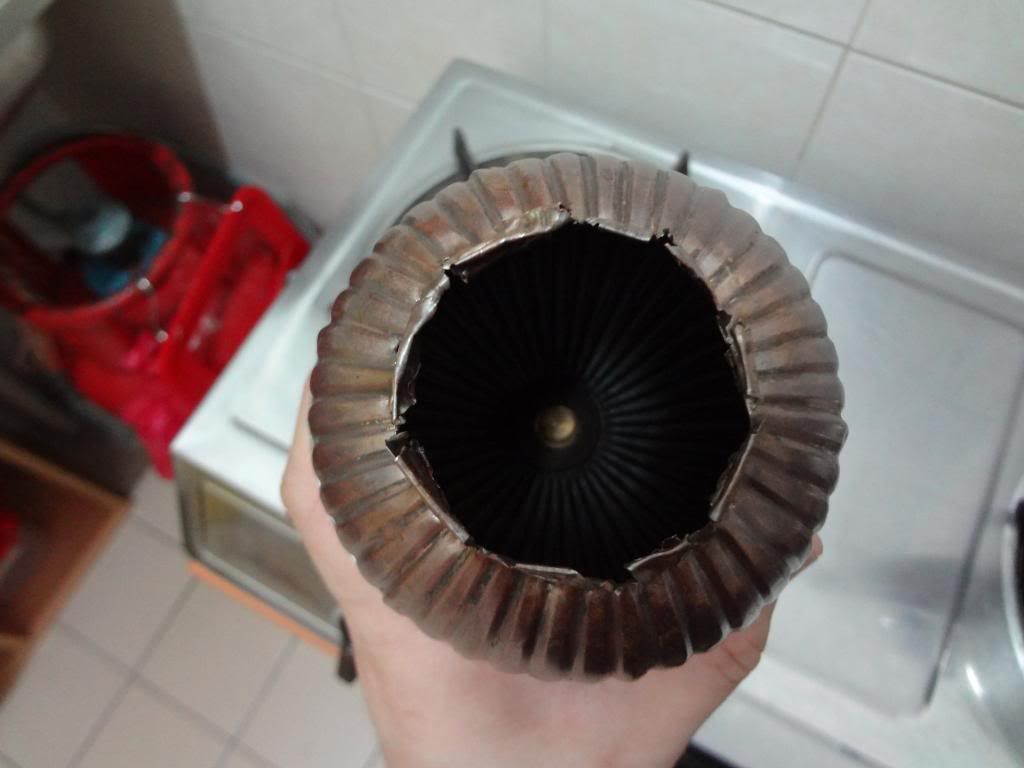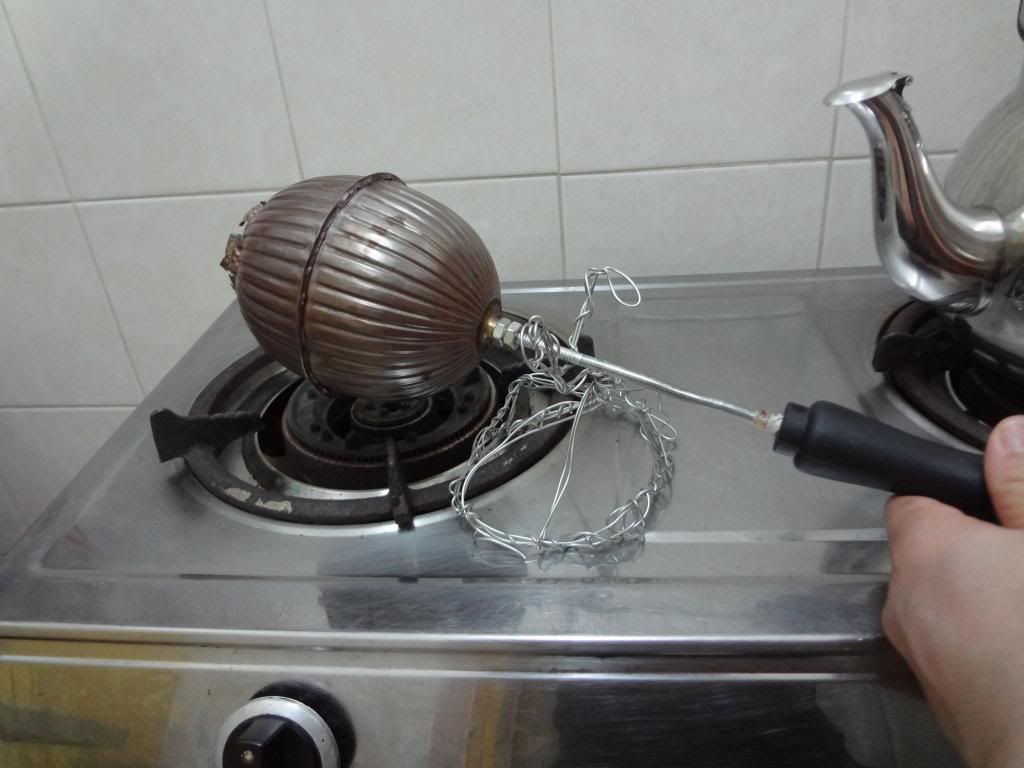Just this weekend, I've finally received one grinder that I've been eye-ing all year long but never pull the trigger because of the price. And eventually, I gave in and bought it with my salary incentive. ;P A clue: It's name is Rosco Mini.
This is yet another hand grinder into my collection. Ever wonder why I am so into hand grinders? Let's do a little bit of reminiscent shall we??
I started my espresso journey with a mere Capresso Infinity. It uses 38-mm conical burrs and has stepped adjustment. It has a black and white theme which looks like beautiful piano. Being in for espresso, the stepped adjustment is sufficient but not perfect. If you have used any grinder before, you will know that grind retention is always the bane in all electrical grinder. For specialty coffee, we strive for freshest coffee and yet there is this some ground coffee that remained in the grind path, that you cannot get it out no matter what. Needless to say, this is also the same story in the Capresso.
Pic: Cappresso Infinity
Staying in the United States at that time, I have abundant access to their second hand grinder market. Subsequently, I upgraded my Cappresso Infinity into a used La Pavoni PGC. It also uses a 38mm conical burrs, a little bit different because it's using a burr design that was coined as Trespade burrs. These burrs are supposedly designed for espresso grinding, and can produce admirable result in the cup. The apparent upgrade, for me, was that it has a stepless worm gear adjustment. This means that you can make a very fine microadjustment to change the grind size and get the perfect flow on your espresso machine. All is good at this point huh? Wait until you turn on the grinder - the thundering sound of this grinder will almost make your neighbor start packing - they thought the apartment is falling apart. Performance wise, it's decent. But there is this quirk of super loud noise as well as the grind retention that made me do another upgrade sooner than I thought.

Pic: La Pavoni PGC Grinder
At that time, I was very active in Coffeegeek forum. It was my fountain of knowledge that time and I spent like half of my awake time reading it. There's so much info out there! Very often, I bumped into the name Super Jolly. It was mentioned over and over again. And I thought the name was very jolly-jolley, very christmas-ey. The Super Jolly was so called the standard in cafes for espresso grinding. So I started paying attention on Ebay for these. Lucky enough, there're plenty of these floating on second hand market due to Starbucks' decision to dump them, in favor of super-automatic machine. I've managed to secure one of these for around USD 200 with shipping cost.
Pic: Mazzer Super Jolly
Super Jolly is manufactured by Mazzer company in Italy. These beasts are no kid man! They are tough as rock and can suffer the most harshest abuse from any cafe and yet make through in one piece. The outer shell is rock solid, the adjustment is controlled in a stepless manner through their threaded collar. As they say, it is the standard of espresso industry. Very tough and quality.
With my Mazzer Super Jolly still performing, I got myself into another good deal of Mazzer Major, less than USD 300 for high end commercial grinder! Super Jolly is using a 64mm flat burr and Mazzer Major is its big brother, a 83mm flat burr! It grinds faster, and everything else is a step meaner as compared to its little brother - including the size!
Pic: Mazzer Major. It may not be very obvious, but this grinder is HUGE, more so with the hopper on
Both the grinders are good. But as mentioned, there's a common theme between them - the grind retention. I single dose mostly at that time and so getting 16g out of 18g beans I put in just doesn't feel right. With both the grinder, I have to develop a routine, a ritual, to brush out the grind that is retained in the chute. The brushing ritual works, but it's a hassle and definitely not the most elegant solution.
And later on, there's this 'most innovative grinder of the year' Baratza Vario that garnered a lot of positive feedback from the Coffeegeeks. After digging through Ebay for quite some times, I eventually bump myself into a decent deal. The Baratza Vario uses a ceramic 54mm flat burr. The ceramic burrs doesn't look very robust, but the proof is in the cup. Some said it is almost on par with Super Jolly in the cup due to its unique burrs design. And most importantly, it is famous for its low retention. With about 18g beans in, I can easily get 17.8g out. Good enough I thought. But as everything, there's always something to complain about. Because the Vario is made from mostly plastic and it is using a Macro-Micro adjustment, the grind setting isn't very robust. It is a hair less intuitive to dial in as compared to other grinder and it requires more grind adjustment from day to day. For me, that is a deal breaker because that would waste a lot of coffee bean and I am stingy on that(being a poor student what). ;P

Pic: Baratza Vario
Then, I came into this
thread. This thread basically got me interested into trying hand grinder. And so I did. My first grinder that I ordered was a Armin Trosser. It was a box coffee mill that is made of wood. My first impression was that the grinder look nice. After loading beans into the chamber, the crank is so difficult to turn. And at its finest setting, it's obvious it couldnt grind espresso as advertised by the ebay seller. And off it go, back to its owner. Thanks to the seller that keeps to his pride and word.Though I don't think I will ever get another similar box mill again, this hand grinder experience definitely got me hooked.
Pic: Armin Trosser vintage coffee grinder
Maybe it's fate, then there is a new hand grinder - OE Pharos, that was designed from scratch was born in the house of
OrphanEspresso. It is using the Titan-sized conical burrs at 68mm. In espresso, Titan Conical burrs are
said and proven to give the best flavors separation and to showcase the single origin coffee best. As you would imagine, I was dying to have one. But owning a Titan Conical grinder is a dream to me at that time, due to the price mainly. Even a used 68mm conical burrs grinder will cost upward of USD 1,000, and not to mention the shipping cost for its size. This 68mm-burrs Pharos comes new at USD 245! It's a fraction of the price of its counterpart, of course minus the motor. I followed closely the owners' review for some while before deciding to get one myself.
Pic: OE Pharos
True enough, as they claimed, the flavors from these burrs are indeed better. But most importantly, it is the other aspects that got me seriously addicted to hand grinding. First, the grind retention is almost negligible. 18g in 17.9g out, sometimes 18g. Grinding motor noise is almost non-existence, except the beautiful sound of the coffee beans cracking inside the burrs. And knowing that the grinder will basically work for a long long time, due to the absence of motor, keeps me a very happy home barista. Another feature of these Titan sized grinder is that they have a larger sweetspot for grind size. You know when you're doing espresso, you have to make fine tweaking to the grind size day-to-day due to the beans aging right? With titan sized grinder, guess what? You don't have to do that or you'll just be doing very very minor tweak. This is just part of the unexpected pleasant surprise.
Eventually, when I finally came back to Malaysia after my graduation, I started my coffee journey again. This time, undoubtedly, my first choice would be hand grinder. Partially due the low retention, and also the durability aspect of a hand grinder. You will never know when the motor will die. It happened to my Cappresso Infinity once but luckily it got replaced under warranty. In Malaysia, if that happens, I suspect the part is difficult to obtain and most likely be very expensive. So, I think I can survive without the motor. ;P A Hario mini was limping along with me for a short while but we said goodbye very soon because of the plasticky built and inferior grind particles.
Thus, I got myself another innovation from
OrphanEspresso. This time it was their Lido grinder. It utilizes a small 38mm conical burrs grinder. I know, it's not the Titan sized. But given the budget, this will be good enough, as better coffee will give off better result than a better grinder. And I am not particularly super fussy on this as long as it's a decently pulled shot.
Pic: OE Lido Hand Grinder
It's true that you have to work out a little using these grinder as compared to pressing one button. But for the better quality coffee(zero retention) and cheaper cost, why not? Plus, by hand grinding you get a feel of the coffee beans, whether it's hard or soft, or whether you're grinding too fine. You actually can pick up those senses. These actually gives me a sense of satisfaction. As they said - hand ground, hand-pulled, hands down!
p/s: I may be adding another 'hand roast' before the 'hand ground', on a 'hand picked' coffee. Hahaha! Will talk about my home roast effort in coming posts.
Lastly, a little sneak peak. ;D Back to the topic, I've just received my Rosco Mini grinder from Ross in Australia as I mention in the start of the entry. First thing first, it's an work of art, and quality! Very precise hand grinder made using solid material and attention to detail. It may looks like the vintage turkish hand grinder, but that is far from the truth - the Rosco mini is on another level! Next time





















































